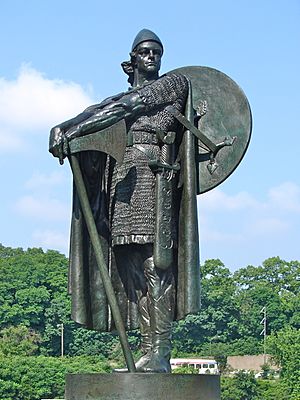Thorfinn Karlsefni facts for kids
Quick facts for kids
Thorfinn Karlsefni Thórdarson
|
|
|---|---|

Statue of Thorfinn by Einar Jónsson
|
|
| Born | c. 980–985 Icelandic Commonwealth
|
| Occupation | Merchant/Trader & Explorer |
| Known for | Early exploration of Vinland |
| Partner(s) | Gudrid Thorbjarnardóttir |
| Children | Snorri Thorfinnsson |
Thorfinn Karlsefni Thórdarson was an Icelandic explorer. Around the year 1010, he sailed to a place called Vinland (which is now part of North America). He wanted to start a new home there with his wife, Gudrid Thorbjarnardóttir, and their group. Thorfinn followed the path that Leif Eriksson had taken earlier.
Contents
What does "Karlsefni" mean?
Thorfinn's special nickname, Karlsefni, means "makings of a man." It can also mean "a real man" or "a strong, good man." This nickname shows that people thought highly of him.
Thorfinn's Journeys
We know about Thorfinn's trips from two old Norse stories called the Grœnlendinga saga (Saga of the Greenlanders) and Eiríks saga rauða (Saga of Eirik the Red). These two stories are often called "The Vinland Sagas." They tell us a lot about his adventures, even though some details are different between them.
Life in Greenland
While in Greenland, Thorfinn met and married Gudrid Thorbjarnardóttir. Gudrid was staying with Leif Eriksson, who was the son of Eirik the Red. Thorfinn and Gudrid decided to explore new lands together.
Exploring Vinland
According to one saga, Thorfinn decided to go to Vínland because Gudrid really wanted to. Leif Eriksson let them use the houses he had built in Vinland. Thorfinn left Greenland with many people, including men and women, and even some animals.
In Vinland, Gudrid gave birth to a boy named Snorri. He was the first child of European parents known to be born in the New World (North America). Many people in Iceland today can trace their family back to Snorri.
The exact place where Thorfinn's group settled is not known for sure. However, it might have been at a Norse site called L'Anse aux Meadows in Newfoundland, Canada.
After some time, the group decided to leave Vinland. They faced challenges and it was hard for everyone to work together. They sailed back to Greenland safely.
Stories of Thorfinn's Adventures
The two main sagas, Grœnlendinga saga and Eirik the Red's Saga, tell Thorfinn's story in slightly different ways.
Saga of the Greenlanders
This saga says that Thorfinn's journey started after he married Gudrid. They brought women and farm animals, showing they planned to stay for a long time. During their trip, they found food like fish, game, and wild grapes. They also cut down trees for wood.
They met the native people, whom they called Skraelings. At first, they tried to trade, but a bull that Thorfinn's group brought scared the natives. This led to some fights. Gudrid gave birth to Snorri before they returned to Greenland.
Eirik the Red's Saga
This saga describes Thorfinn Karlsefni as a successful trader from Iceland. He sailed to Greenland with many men and was welcomed by Eirik the Red. Thorfinn married Gudrid that winter.
He then set off with three ships and many men to find Vinland. They explored new areas, finding places with wild grain and grapes. They met the native people and traded with them. However, a bull from Thorfinn's group again frightened the natives, leading to conflict.
After their adventures, Thorfinn and Gudrid returned to Greenland. Later, they went back to Thorfinn's farm in Iceland.
Thorfinn's Family
Thorfinn Karlsefni was born around 980–985 in Iceland. His father was Thord Horsehead, and his mother was Thorunn. Thorfinn likely grew up on his father's farm called Stad. This farm was in an area known as Skagafjord.
Thorfinn later returned to this area in Iceland after his explorations. One saga says he went back to his old farm, while another says he bought new land nearby.
Thorfinn in Art
In the early 1900s, an Icelandic artist named Einar Jónsson created a statue of Thorfinn Karlsefni. This statue was placed in Philadelphia, USA, in 1920. It was meant to represent the history of America. Another copy of the statue is in Reykjavík, Iceland.
The statue in Philadelphia faced some challenges in recent years. It was damaged and removed for repairs. The city is thinking about its future placement.
See also
 In Spanish: Thorfinn Karlsefni para niños
In Spanish: Thorfinn Karlsefni para niños

